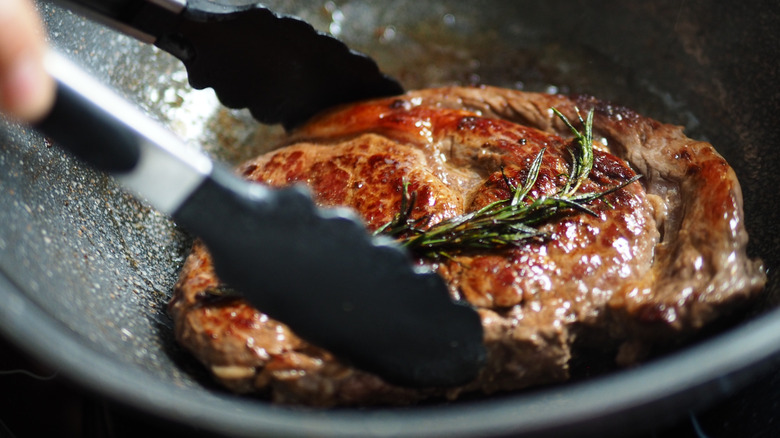Not Preheating Your Skillet Is A Major Mistake. Here's Why
There are a lot of common skillet mistakes that can ruin your pan-seared steaks and other foods. One particular mistake pertains to cooking (almost) all types of ingredients in all types of skillets (and yes, skillets and frying pans are the same thing). It's one of the most widespread errors in all stovetop cooking: It's a mistake not to preheat your skillet.
A preheated skillet helps with both the Maillard reaction and caramelization. The Maillard reaction is, essentially, browning. It's the reaction that happens when proteins and sugars are heated — the quicker they're heated, the faster it happens. It sears a crust into protein-rich foods like meats, eggs, and fish to seal in juices and create new savory, salty, and umami flavor. Caramelization happens when sugars react with water and heat and are reformed into caramel, giving them the distinctive toasted, sometimes bitter flavor. It makes sautéed onions, peppers, and squash (among others) sweeter and nuttier.
A searing hot skillet rapidly evaporates the exterior moisture in foods, creating a barrier for potatoes that are crispy on the outside and soft and buttery on the inside, without sticking to the skillet. It cuts down on cooking times and keeps your food from drying out as the pan heats up. Preheating your pan will also improve even heat distribution. While relevant with all types of skillets, heat distribution is particularly important with cast iron, which will take longer to heat up and remain hotter closer to the flame or heat source.
How to preheat your skillet and when not to
Put your skillet over medium to medium-high heat to heat it thoroughly. In about a minute, you should be able to feel the heat radiating off it when you hold your hand a few inches above. For cast iron, depending on the size of the skillet, you can move it around the flame for a few minutes so that it thoroughly heats every part of the pan. Because it's not a perfectly even heat conductor, however, cast iron may still have hot spots and cooler spots as it cooks. For cast iron, you can even put the pan in the oven, set it to the desired temperature, and let it heat up appropriately. This will help with heat distribution. Another technique to test skillet heat is to flick a few drops of water on your pan, and if they sizzle off almost immediately, you should be good to go.
Follow the recipe to see what level of heat is required. If it says "smoking hot," you should probably follow the instructions. And if it says to start without preheating your pan, you should follow that, too. There are certain foods that don't benefit from a screaming hot pan. Bacon, for example, will actually stick to a hot pan and should be started cool. Garlic, especially sliced garlic, burns quickly and should be started low. If you're attempting to brown butter, it will simply burn in a hot pan. And, if you want to sauté onions to full translucent caramelization, starting at a low temperature will give you more control. Now that you have a handle on the heat, it may be time to learn how to toss food in a skillet like a pro.

